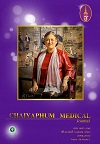ปัจจัยเสี่ยงของการติดเชื้อดื้อยา Acinetobacter baumannii ในโรงพยาบาลชัยภูมิ : Risk Factors for Multi-Drug Resistant Acinetobacter baumannii Nosocomial Infection, Chaiyaphum Hospital
Abstract
บทคัดย่อ
วัตถุประสงค์: เพื่อศึกษาปัจจัยที่มีความสัมพันธ์กับการติดเชื้อดื้อยา A. baumannii ในโรงพยาบาล
วิธีการศึกษา: การศึกษาแบบย้อนหลัง เพื่อศึกษาปัจจัยที่มีความสัมพันธ์กับการติดเชื้อดื้อยา A. baumannii โดยศึกษาในผู้ป่วยที่เข้ารับการรักษาในโรงพยาบาลชัยภูมิระหว่าง 1 ตุลาคม พ.ศ. 2556 ถึง 30 กันยายน พ.ศ. 2557 กลุ่มตัวอย่างคือ ผู้ป่วยที่ติดเชื้อดื้อยา A. baumannii ในโรงพยาบาลจำนวน 60 คน และกลุ่มควบคุมคือ ผู้ป่วยที่ไม่มีการติดเชื้อในโรงพยาบาลจำนวน 120 คนจับคู่ 1:2 ด้วยหอผู้ป่วยและอายุ เครื่องมือที่ใช้ในการรวบรวมข้อมูล ประกอบด้วย แบบบันทึกข้อมูลทั่วไปผู้ป่วย และข้อมูลการรักษา วิเคราะห์ข้อมูลโดยใช้สถิติเชิงพรรณนา การทดสอบทีไควสแควร์ และการถดถอยพหุโลจิสติก
ผลการศึกษา: อายุเฉลี่ยในกลุ่มศึกษา 65.9 ± 15.7 ปี และในกลุ่มควบคุม 59.5 ± 18.2 ปี ระยะนอนโรงพยาบาลเฉลี่ยในกลุ่มศึกษา 36.4 ± 23.6 วัน และในกลุ่มควบคุม 5.2 ± 9.9 วัน ผลการวิเคราะห์ตัวแปรเชิงซ้อน พบว่าปัจจัยที่มีความสัมพันธ์ต่อการติดเชื้อดื้อยา A. baumannii ในโรงพยาบาล ได้แก่ การใส่สายสวนปัสสาวะมากกว่า 1 สัปดาห์ (OR=15.45, 95%CI = 3.47-76.41, p < .001) การใส่เครื่องช่วยหายใจมากกว่า 1 สัปดาห์ (OR= 5.33, 95%CI = 2.67-26.01, p = .002) การใส่สายยางให้อาหารทางจมูกมากกว่า 1 สัปดาห์ (OR=10.58, 95%CI = 1.97-64.72, p < .001) และการรักษาด้วยยากลุ่มเซฟาโลสปอรินส์ (OR=3.53, 95%CI =1.54-8.07, p < .001) ยากลุ่มคาร์บาพีเนมส์ (OR= 5.64, 95%CI = 3.21-18.19, p < .001) ยากลุ่มควิโนโลน (OR= 4.16, 95%CI = 1.59-32.05, p = .017) และยากลุ่มลินโคซาไมด์ (OR= 3.52, 95%CI = 1.46- 20.86, p = .016)
อภิปรายผล: การศึกษาแสดงให้เห็นว่าปัจจัยเสี่ยงต่อการติดเชื้อดื้อยา A. baumannii ในโรงพยาบาล มีหลายปัจจัยโดยเฉพาะผู้ป่วยที่ได้รับการสอดใส่อุปกรณ์เข้าร่างกายและได้รับยาต้านจุลชีพบางขนาน ควรมีการส่งเสริมการใช้มาตรการการป้องกันการติดเชื้อดื้อยาในผู้ป่วยที่มีปัจจัยเสี่ยงอย่างเข้มงวด
Abstract
Objective: To assess factors associated with multi-drug resistant Acinetobacter baumannii (MDR-AB) nosocomial infection.
Material and Method: The case-control study was conducted in patients admitted to Chaiyaphum Hospital between October 1, 2013 to September, 30, 2014. The study population consisted of 60 cases with MDR-AB nosocomial infection and 120 controls without nosocomial infection. The cases were matched with controls by age and ward of admission with a ratio of 1: 2. The research instruments included demographic data, and patient recording form. Data were analyzed using descriptive statistics, t- test, chi-square test and multivariate logistic regression.
Results: The average age of the present study population was 65.9 ± 15.7 years among cases and 59.5 ± 18.2 years among controls. The mean of length of stay in hospital among cases was 36.4 ± 23.6 days and controls 5.2 ± 9.9 days. Multiple logistic regression analysis showed the following associated factors with MDR-AB nosocomial infection: indwelling urinary catheter > 1 week (OR=15.45, 95%CI = 3.47-76.41, p < .001), mechanical ventilation >1 week (OR= 5.33, 95%CI = 2.67-26.01, p = .002), nasogastric intubation > 1 week (OR=10.58, 95%CI = 1.97-64.72, p < .001), prior administration of cephalosporins (OR=3.53, 95%CI =1.54-8.07, p < .001), carbapenems (OR= 5.64, 95%CI = 3.21-18.19, p < .001), quinolones (OR= 4.16, 95%CI = 1.59-32.05, p = .017), and lincosamides (OR= 3.52, 95%CI = 1.46- 20.86, p = .016).
Conclusion: There were many risk factors associated with MDR-AB nosocomial infection, including use of devices and previous antimicrobial therapy. To reduce antimicrobial resistant bacterial nosocomial infection, strict infection control measures must be applied to the patients with these risk factors.
Downloads
Published
Versions
- 2021-09-02 (2)
- 2019-07-30 (1)
Issue
Section
License
Copyright (c) 2019 Chaiyaphum Medical Journal : ชัยภูมิเวชสาร

This work is licensed under a Creative Commons Attribution-NonCommercial-NoDerivatives 4.0 International License.





